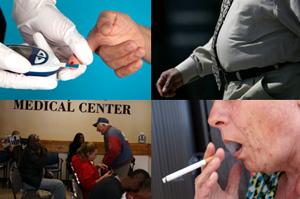
If you had $15 billion to spend on preventing disease in the U.S., where do you think it would do the most good? Fighting obesity? Smoking? Maybe encouraging exercise? There’s a sharp divide on the answer to the question of how to spend a prevention fund over the next 10 years.
Some nonprofit groups want the bulk of the money to prevent specific diseases. Public health officials want to bolster agencies whose work targets a broad range of the causes of death and disability. Others advocate using the fund to transform communities to make it easier to exercise and buy fresh produce.
Now it is up to the Department of Health and Human Services to decide how to divide up the fund, created by the new health care overhaul law.
“In Washington, if you throw a dollar on the table, you have to be quick or get out of the way: There will be a number of very legitimate interests in this money,” says Paul Jarris, executive director of the Association of State and Territorial Health Officials, which represents state health agencies.
One thing prevention advocates agree on: they’re disappointed that the fund, which will disburse money over 10 years, isn’t bigger. Even so, they say it’s a big boost for their efforts — the largest increase in federal prevention dollars since 9/11, says Richard Hamburg, deputy director of the Trust for America’s Health, a nonprofit advocacy group promoting disease prevention.
The timing couldn’t be better. Eighty-five percent of health departments surveyed by association of health officials say they have reduced services since July 2008, often because of state budget shortfalls.
This fiscal year, for example, California ended case management services for 9,500 pregnant or parenting teens and cut by almost half the number of people it assists in a program to reduce infant mortality rates among African Americans. Arizona officials suspended state funding for diabetes prevention, primary care services at community health centers and local venereal disease control programs. And in Michigan, a program to provide screenings for breast and cervical cancer was sharply scaled back.
Money from the new fund could help transform prevention efforts and slow the growth of spending on health care, a large percentage of which is now driven by patients with preventable chronic illnesses, says Ken Thorpe, a professor of health policy at Emory University.
The money comes amid an increased focus on prevention, including First Lady Michelle Obama’s promotion of efforts to fight childhood obesity. This year, $500 million from the new prevention fund will be distributed in a process the Department of Health and Human Services has not yet outlined. Amounts will rise each year. In 2015 and beyond, the fund will give out $2 billion a year.
Organizations that have written the department so far include:
— The American Diabetes Association and other diabetes groups requested one-third of the money — $5 billion for diabetes prevention and management, citing the disease’s “significant human and financial toll.”
— Anti-smoking groups, including the American Lung Association and the Campaign for Tobacco-Free Kids, want the bulk of the funding to go to public education campaigns to discourage smoking, telephone hotlines to help people quit and existing tobacco control programs.
— The Association of State and Territorial Health Officials wants 35 percent of the money to go to state and local health departments, 44 percent to community prevention and wellness efforts, 10 percent to research, 10 percent to the federal Centers for Disease Control and Prevention and the rest to prevention task forces.
— The Prevention Institute, a nonprofit advocacy group, and the research group PolicyLink, told the department the money should be used to go beyond traditional programs and into “community prevention,” which would ensure people have access to “safe, healthy places to live, play and learn.”
The need is clear, say prevention advocates: A decades long slowdown in smoking rates has stalled, leaving about 21 percent of Americans using tobacco, the leading cause of preventable death.
Meanwhile, the rate of obesity has increased markedly: Currently, nearly 34 percent of Americans are obese, putting them at risk for heart disease, diabetes and other health problems.
Smoking and obesity programs were the main focus of more than $372 million in stimulus bill funding given to 44 communities earlier this year. Because they were two-year grants, most of the money went to existing programs. With the health care law calling for $500 million of the fund to be allocated this year, communities that applied, but were not chosen, for the stimulus funding may be at an advantage in getting some of the new funds.
Yet some argue that while it made sense with the stimulus’ shorter time frame to give money to communities with shovel-ready projects, the government should take a different tack with the new money.
“If you just go down the (stimulus grant) list and give the money to high-infrastructure communities, we will be institutionalizing disparities in this country,” says Jarris. “Those (areas) will get more, and places like Mississippi and Arkansas who don’t have that will be left out.”
Among the states that received no funding from the stimulus prevention program were Mississippi, Louisiana and Arkansas all of which consistently rank high in smoking and obesity rates.
Thorpe says money can be spread equitably and should focus on the types of programs shown to work by research, such as diabetes efforts offered through local YMCAs, or efforts recommended by the Task Force on Community Preventive Services, an independent review board whose members are appointed by the Centers for Disease Control and Prevention director.
“If we can continue to push down smoking rates and obesity through school based, community based and workplace based programs, that will make an impact on a whole series of chronic illnesses,” says Thorpe.






